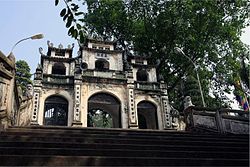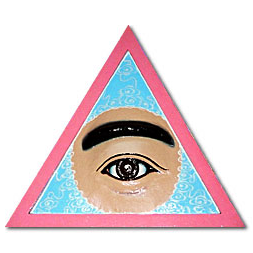
Caodaism is a monotheistic syncretic religion officially established in the city of Tây Ninh in southern Vietnam in 1926. The full name of the religion is Đại Đạo Tam Kỳ Phổ Độ.

Bắc Ninh is a province of Vietnam, located in the Red River Delta of the northern part of the country. It is situated to the east of the Vietnamese capital, Hanoi, and borders Bắc Giang Province, Hưng Yên Province, Hải Dương Province, Thái Nguyên Province and Hanoi. The province's name derives from Sino-Vietnamese 北寧 and literally means "northern serenity".

Tây Ninh, Vietnam is a provincial city in south-western Vietnam. It is the capital of Tây Ninh Province, which encompasses the town and much of the surrounding farmland. Tây Ninh is approximately 90 km to the northwest of Ho Chi Minh City, Vietnam's largest city. As of 2013, the city had a population of 153,537, and a total area of 140 km².

Ninh Thuận is a province in the South Central Coast region of Vietnam.
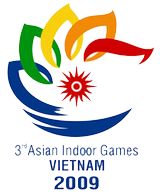
The 3rd Asian Indoor Games were held in Vietnam from 30 October till 8 November 2009.

Long-established religions in Vietnam include the Vietnamese folk religion, which has been historically structured by the doctrines of Confucianism and Taoism from China, as well as a strong tradition of Buddhism. According to official statistics from the government, as of 2014 there are 24 million people identified with one of the recognised organised religions, out of a population of 90 million. Of these, 11 million are Buddhists (12.2%), 6.2 million are Catholics (6.9%), 4.4 million are Caodaists (4.8%), 1.4 million are Protestants (1.6%), 1.3 million are Hoahaoists (1.4%), and there are 75,000 Muslims, 7,000 Bahá'ís, 1,500 Hindus and other smaller groups (<1%). Traditional folk religions have experienced a rebirth since the 1980s.

Long Xuyên is the provincial city and capital city of An Giang Province, in the Mekong Delta region of south-western Vietnam. It is located at approximately 1,950 km south of Hanoi, 189 km from Ho Chi Minh City, and 45 km from the Cambodian border. The population of Long Xuyên city is over 368,376 (2013), with an area of only 106.87 km².
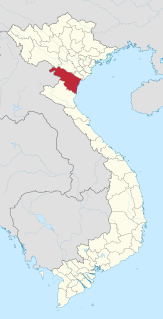
Thanh Hóa is a province in the North Central Coast region of Vietnam. This is a relatively large province, which ranks as fifth in area and as third in population among 63 central administrative subdivisions. Its capital and largest city is Thanh Hóa City. The province is widely called Xứ Thanh which means Thanh Hóa land in Vietnamese.

Tourism in Vietnam is a component of the modern Vietnamese economy. In 2012, Vietnam received more than 6.8 million international arrivals, up from 2.1 million in the year 2000. The annual increase represented a rebound from a decline in 2008 Great Recession. The Vietnam National Administration of Tourism is following a long-term plan to diversify the tourism industry, which brings foreign exchange into the country.

The Thien Hau Temple, officially the Ba Thien Hau Pagoda, is a Chinese-style temple of the Chinese sea goddess Mazu on Nguyễn Trãi Street in the Cho Lon ("Chinatown") of District 5 in Ho Chi Minh City, Vietnam.
Thiên Y A Na is a Vietnamese goddess. She is worshipped in the Vietnamese folk religion and Đạo Mẫu, the mother goddess religion. She is also known as Lady Po Nagar, the Cham deity from whom she originated. The Cham people of Vietnam had been much influenced by India, and it is believed that Pô Nagar is represented with the characteristics of Bhagavati Uma. The cult of Thiên Y A Na is popular in Vietnam, particularly among women. She is channeled through Lên đồng rituals. There have been many temples and shrines devoted to her throughout the last several centuries.

Princess Liễu Hạnh is one of The Four Immortals of Thanism, and also a leading figure in the mother goddess cult Đạo Mẫu, in which she governs the celestial realm.

Đạo Mẫu is the worship of mother goddesses in Vietnam. While scholars like Ngô Đức Thịnh propose that it represents a systematic mother goddess cult, Đạo Mẫu draws together fairly disparate beliefs and practices. These include the worship of goddesses such as Thiên Y A Na, The Lady of the Realm, The Lady of the Storehouse and Princess Liễu Hạnh, legendary figures like Âu Cơ, the Trưng Sisters, and Lady Triệu, as well as the cult of the Four Palaces. Đạo Mẫu is commonly associated with spirit mediumship rituals—known in Vietnam as lên đồng—much as practiced in other parts of Asia, such as Southern China, Myanmar and some community in India... Although the Communist government had initially proscribed the practice of such rituals, deeming them to be superstitions, they relented in 1987, once again legalizing their practice.

Đồng Lộc Junction was a strategic road T-junction at the beginning of the Ho Chi Minh trail which was extensively bombed by American forces during the Vietnam War. Although it is often referred to a "crossroads" in English sources, a crossroads is ngã tư (4-junction), whereas a T-junction is ngã ba (3-junction).
Lâm Cung Thánh Mẫu (林宮聖母) or Mẫu Thượng Ngàn or Bà Chúa Thượng Ngàn is ruler of the Forest Palace among the spirits of the Four Palaces in Vietnamese indigenous religion. In legend the Princess of the Forest was the daughter of prince Sơn Tinh and Mỵ Nương, công chúa Quế Mỵ Nương King Hung's daughter from the legend of the rivalry between Sơn Tinh and the sea god Thủy Tinh. Many natural features around Vietnam feature shrines to her, such as the Suối Mỡ thermal springs area near the town of Bắc Giang.
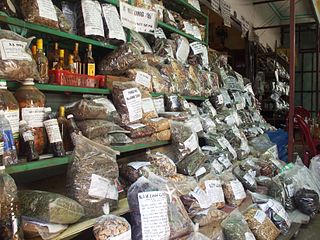
Traditional Vietnamese medicine, also known as Southern Herbology is a traditional medicine practiced by Vietnamese people. It is influenced by traditional Chinese medicine. The other traditional medicine that is also practiced in Vietnam is traditional Chinese medicine, also known as Northern Herbology. Thuốc Nam is one of two kinds of folk remedies known to villagers, the other being the traditional exercise dưỡng sinh.
